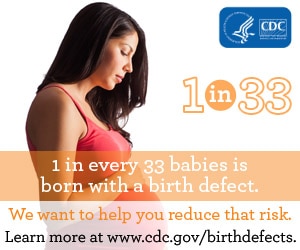On April 17, we welcomed our daughter Charlotte into the world. During my entire pregnancy, I was convinced that she was going to be a chunky, dark-haired baby just like I had been. I was so shocked to see reddish blonde hair and blue eyes on our a tiny, tiny baby. She also had a cleft lip.
In the grand scheme of things, a cleft lip is not a big deal. Especially when you take into consideration that my first pregnancy ended in a miscarriage. But it added another complicated layer to the already complicated world of motherhood. Would she have problems with feeding? Was her palate okay? What complications could this present for her in the future? And most importantly — what did I do wrong during my pregnancy to cause this?
It turns out that her lip wasn’t caused by anything “wrong” that I did. She just happened to be among the 1 in 33 babies born with a birth defect.

January is Birth Defects Prevention month. Not all defects can be prevented. However, there are some steps that expectant mothers can take to help decrease risks. According to the Center for Disease Control (CDC), expectant mothers should make a “PACT” for prevention. To spell it out: plan ahead, avoid harmful substances, choose a healthy lifestyle, and talk to her healthcare provider (source).
If you have a child born with a birth defect, there are many resources your family can turn to for support. The CDC has a list of organizations that offer support and information about specific birth defects and conditions. The Birth Defects Research for Children group also has a comprehensive list of support groups organized alphabetically by condition. We are also extremely fortunate in the Nashville area to have a world-class children’s hospital in our city. Vanderbilt Children’s offers support resources and performed the surgery that corrected Charlotte’s cleft lip.


If you have a child with a birth defect, it may be scary and overwhelming. But you are not alone. Check out the lists on the websites listed above. Take a look on social media for other local groups to connect with other parents and children going through the same journey.















